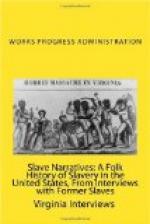“I’d rather have de days as dey is now in some ways. But one thing I does lak to do is eat and us had a plenty of good eatin’ den and never had to worry none ‘bout whar it was a-comin’ f’um. Miss, ain’t you through axin’ me questions yet? I’m tired of talkin’. I done let de fire go out under my washpot twice. Dem white folks ain’t gwine to lak it if dey has to wait for deir clothes, and dis misery in my laigs, it sho’ does hurt me bad dis mornin’.”
MARTHA EVERETTE, EX-SLAVE Hawkinsville, Georgia
(Interviewed By Elizabeth Watson—1936)
[JUL 20 1937]
Born in Pulaski County about 1848, the daughter of Isaac and Amanda Lathrop, Martha Everette has lived all her life near where she was born.
Prior to freedom, her first job was “toting in wood”, from which she was soon “promoted” to waiting on the table, house cleaning, etc. She make no claims to have ever “graduated” as a cook, as so many old before-the-war Negresses do.
“Aunt” Martha’s owner was a kind man: he never whipped the slaves, but the overseer “burnt ’em up sometimes.” And her mother was a “whipper, too”—a woman that “fanned” her children religiously, so to speak, not overlooking Martha. All the Watson slaves attended the (White) Baptist church at Blue Springs.
Rations were distributed on Sunday morning of each week, and the slaves had plenty to eat. The slaves were also allowed to fish, thus often adding variety to their regular fare.
Negro women were taught to sew by the overseers’ wives, and most of the slaves’ clothes were made from cloth woven on the plantation. The Yankees visited the Lathrop plantation in ’65, asked for food, received it, and marched on without molesting anything or any body. Truly, these were well-behaved Yankees!
“Aunt” Martha says that she remembers quite well when the Yankees captured Jefferson Davis. She and other slave children were in the “big house” yard when they heard drums beating, and soon saw the Yankees pass with Mr. Davis.
“Aunt” Martha, now old and decrepit, lives with one of her sons, who takes care of her. This son is a gardener and a carpenter and, being thrifty, fares much better than many Negroes of his generation.
[HW: Dist. 5
Ex-Slave #30]
By E. Driskell
Typed by A.M. Whitley
1-29-37
FIRST COPY OF ARTICLE ENTITLED:
“AN INTERVIEW WITH LEWIS FAVOR,” EX-SLAVE
[MAY 8 1937]
[TR: informant also referred to as Favors in this document.]
Among Atlanta’s few remaining ex-slaves is one Lewis Favors. When he fully understood this worker’s reasons for approaching him he consented to tell what he had seen and experienced as a slave. Chewing slowly on a large wad of tobacco he began his account in the following manner: “I was born in Merriweather County in 1855 near the present location of Greenville, Georgia. Besides my mother there




